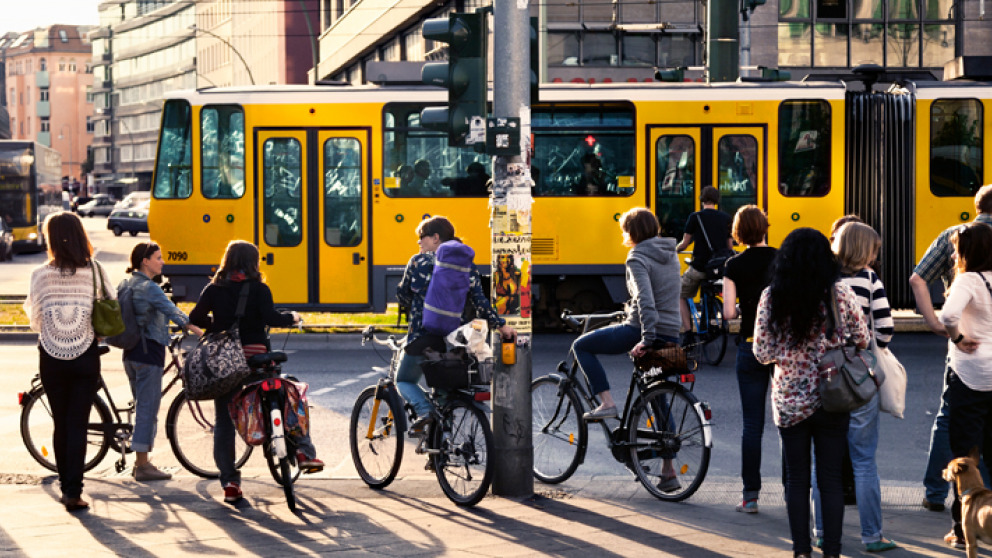Headline:
More Cycle Traffic to Improve Air Quality in Berlin and Potsdam – a Model Study

Cycling is good – not just for our health, our spirits and our wallets, but also for the climate and air quality. But to what extent is air quality actually improved when a city or even a whole country convinces its citizens to leave the car at home and get on their bikes? To date, very little research has been done on this question. A new IASS study hopes to provide some answers.
Because one thing is clear: air pollution is currently the main environmental cause of premature death among Europeans. Although the EU has introduced wide-ranging regulations to ensure good air quality, there’s still a long way to go before nobody’s health is endangered by the air they breathe. This is especially true of cities: in 2012, 10 to 14% of all EU city dwellers were exposed to fine particulate matter[1] in excess of European limits, and over 90% had to contend with air quality that the World Health Organisation has classified as harmful. Even in Berlin and Potsdam, limit values for air pollution are regularly exceeded in some places.
Why are transportation measures so effective when it comes to improving air quality?
Emissions from traffic – i.e. “the fumes that come out of your exhaust pipe” – are the main cause of air pollution in cities. To give an example, they account for around two thirds of the nitrogen dioxide (NO2) concentrations in the air that are so harmful to our airways. In Europe, 90% of all exceedances of NO2 limit values were recorded at measuring stations in the vicinity of traffic.[2]
Measures such as the establishment of low-emissions zones have already helped to improve air quality in many cities. But more needs to be done to reduce traffic-based emissions in the long term. A switch from cars to bikes already plays a role in the air quality and mobility plans of many cities. However, little research has been carried out so far on the effect of individual measures to encourage cycling.
Are there no existing studies on this issue?
There are a few studies that investigate the effects of a switch from cars to bicycles on air quality. Yet the scientific literature tends to focus either on how air pollution impinges on cyclists’ health or on the health benefits that result when other modes of transport increasingly replace cars. There is still no scientific study that quantifies the improvement in air quality that would result from more cycling and less car journeys.
So what’s our contribution at the IASS?
In the context of a range of different activities on air quality in the Berlin-Brandenburg Metropolitan Area, we at the IASS are currently planning a study that should help to close this knowledge gap. We want to find out what can be achieved by lowering the number of car journeys and increasing the number of bicycle journeys in this region. The model study will form part of the PhD I recently started working on.
For the study we plan to cooperate with local partners to develop scenarios for Berlin and Potsdam, which we will then analyse using the atmospheric model WRF-Chem. The advantage of this modelling system is that it takes account of many important and complex processes in the atmosphere. Pollutants are influenced by local emissions, but they also interact with substances that are emitted elsewhere, not necessarily by motor vehicles. To complicate matters, these processes are also influenced by weather conditions.
The scenarios that we want to simulate should show the upper and lower limits of any improvement in air quality due to a switch from cars to bikes. In other words, they should represent the difference between an optimistic and a pessimistic scenario. After that, we will examine what these measures could contribute to adhering to European limit values and the health benefits that would result from that. We also want to ascertain if and how the findings of the study for Berlin and Potsdam are also applicable to other urban centres in Europe. Overall, we hope that the results of this study will give us a clearer picture of the air quality goals we can attain by replacing car journeys with bicycle journeys in cities.
Header photo: istock/Eldad Carin
[1] Fine particulate matter is defined as particles with a diameter of 2.5 micrometres (µm) or less.
[2] My own calculation based on data from AirBase - The European air quality database, version 8.

Add new comment